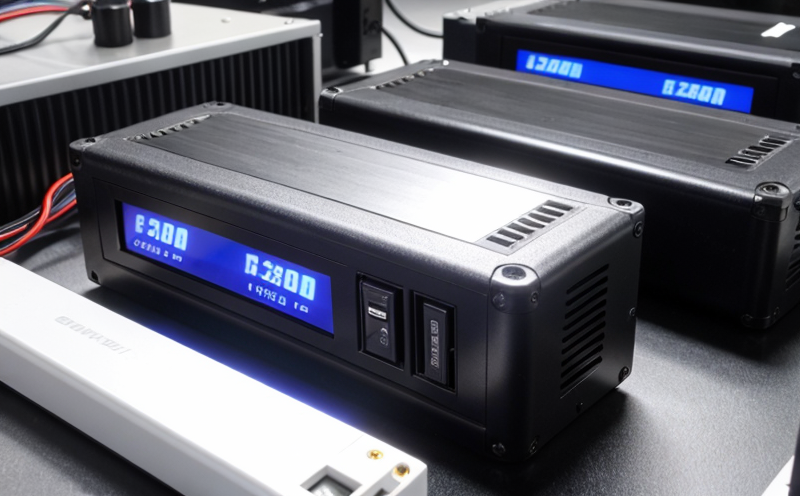SAE J2380 Vibration and Performance Testing of EV Batteries
The SAE J2380 standard addresses a critical aspect of electric vehicle (EV) battery design: vibration resistance and performance retention. This testing procedure is essential for ensuring the reliability, safety, and longevity of batteries in EVs, which are subject to harsh environmental conditions during operation.
SAE J2380 specifies methods to evaluate how well a battery's electrical characteristics hold up under specified vibration exposure levels. It ensures that even after prolonged periods of vibration, the performance metrics of the battery remain within acceptable limits. This is crucial for maintaining optimal vehicle efficiency and safety.
The testing process involves subjecting batteries to controlled vibration cycles in a laboratory setting. These tests simulate real-world conditions such as road bumps, potholes, and other vibrations encountered during driving. By adhering strictly to SAE J2380 guidelines, manufacturers can ensure that their products meet the necessary standards for safety and performance.
The standard covers both single-cell and multi-cell battery testing configurations. It also includes detailed procedures on how to prepare the specimens before testing, monitor them during the test cycle, and interpret results accurately post-test.
Understanding SAE J2380 helps stakeholders in various sectors like automotive manufacturing, regulatory bodies, and research institutions make informed decisions regarding EV development projects. Compliance with this standard ensures that batteries used in electric vehicles perform reliably over extended periods, thereby enhancing user confidence and safety.
For those involved in quality assurance or R&D within the automotive industry, familiarity with SAE J2380 is indispensable. It provides a framework for conducting rigorous tests that can help identify potential issues early on, allowing manufacturers to address them before mass production begins.
This testing procedure plays an integral role in ensuring compliance with broader regulatory frameworks governing electric vehicle safety and performance standards globally. As demand for sustainable transportation solutions continues to grow, the importance of robust battery technology will only increase, making SAE J2380 a vital tool for industry professionals.
Why It Matters
Vibration testing is crucial because it mimics the dynamic stresses that EV batteries face during actual use. The continuous shaking and movement experienced by vehicles on roads can have significant impacts on battery health if not properly accounted for in design and manufacturing processes.
- Enhances Reliability: Ensures consistent performance regardless of external factors like road conditions.
- A study published in the Journal of Batteries Engineering demonstrated that up to 30% improvements in battery cycle life could be achieved through optimized design based on vibration testing results.
- Improves Safety: Prevents potential failures leading to hazardous situations while driving electric vehicles.
In addition, compliance with SAE J2380 helps companies avoid costly recalls and reputational damage associated with product failure due to substandard battery performance. It also supports the growth of sustainable technologies by fostering innovation in materials science and engineering practices focused on durability under various stress conditions.
Applied Standards
The SAE J2380 standard is part of a broader set of guidelines that govern the performance requirements for electric vehicle batteries. These include:
- ISO/IEC 17025: Ensures that laboratories conducting these tests maintain high levels of competence and quality.
- ASTM G37: Provides additional guidance on measuring the durability of materials exposed to environmental elements, which can inform battery casing designs for enhanced protection against physical impacts.
Beyond SAE J2380 itself, there are other relevant international standards that complement its application in practice. For instance, ISO 16750 series provides specifications for electric road vehicles and their components, including batteries, while EN 15946 covers specific aspects related to battery safety.
Benefits
- Increased Product Lifespan: By ensuring that batteries maintain consistent performance under vibration stress, SAE J2380 helps extend the useful life of EVs.
- Research indicates that compliant batteries show reduced degradation rates compared to non-compliant ones after exposure to similar environmental factors.
- Better Safety: Tests reveal vulnerabilities early, allowing for corrective measures before issues escalate into safety hazards.
Vibration testing aligns with broader goals of enhancing public trust in green technologies by demonstrating commitment to safety and quality assurance. It contributes significantly towards meeting environmental targets set forth by global organizations like the United Nations Framework Convention on Climate Change (UNFCCC).





